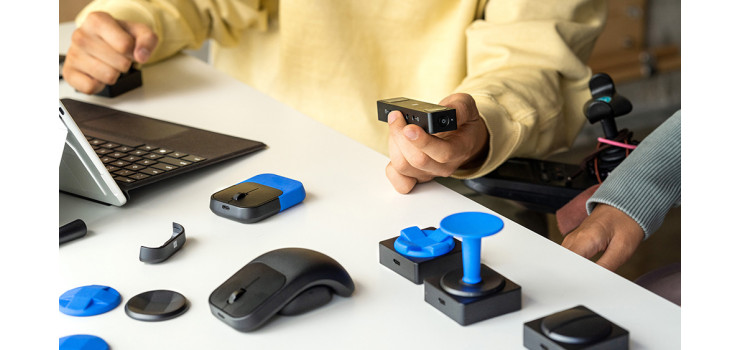
Jara Helmes uses the Adaptive Mouse and Adaptive Button. (photo by Debby Hekkens)
When Jara Helmes was a toddler walking with stiff, heavy leg braces, her father made her a lighter, softer pair 3D-printed in her favorite color, pink. When Jara began using a computer at school and couldn’t control the mouse, her dad envisioned making another custom device for his daughter, who has cerebral palsy.
But this time, John Helmes, an industrial designer at Microsoft, had a bigger project. He brought his idea, an adaptable mouse for people who can’t use a traditional mouse, to the company’s Hackathon, an annual innovation event for employees. He assembled a large team to build a prototype from a Microsoft Arc mouse they cut and attached to a 3D-printed piece designed for finger support and control. The device reduced unintended clicks and helped Jara, then 5, control her computer cursor for the first time.
Two years and many iterations later, that early prototype has evolved into the new Microsoft Adaptive Accessories, a highly adaptable ecosystem that lets users customize their mouse, keyboard inputs and shortcuts. The accessories include the Adaptive Mouse, Adaptive Hub and Adaptive Buttons and are now generally available.
“In the beginning, it was, ‘Jara can’t use a PC. I’m her father. Let’s hack a way for her to use the PC,’” says Helmes, who lives in the Netherlands. “But really quickly, I thought, ‘Hold on. If this works for her, this could have the same impact for so many other people.’”
The wireless accessories can replace or augment a traditional mouse and keyboard for users with limited mobility or anyone who wants to use a PC more easily and efficiently. Users can customize the Adaptive Mouse with different attachments, including a mouse tail extension and a thumb support configurable for the left or right hand. They can create custom inputs without a keyboard through the Adaptive Hub and Adaptive Button, which is available as a D-pad, joystick and dual button. The mouse and button can be further customized with 3D-printed attachments from the company Shapeways.
“The Microsoft Adaptive Accessories are intended to remove the barriers that traditional mice and keyboards may present to people with limited mobility,” says Gabi Michel, director of Accessible Accessories at Microsoft. “No two people are alike, and empowering people to configure their own system that works for them was definitely the goal.”
The button and hub have helped Mandy Pursley, a graphic designer and voice-over artist in North Carolina, work faster and with less shoulder pain. Born without a right hand and forearm, Pursley had been typing and mousing with her left hand. With the adaptive products, she was able to program the button with macros that replace repetitive mouse-and-keyboard tasks and actions that require pressing several keys at once.
“The button has been the most awesome thing. It literally feels like they made it just for me,” says Pursley, who recently timed herself working on a 500-page project with the easy-to-press button. She found that she could work 30% faster, saving hours of time.
“This is going to make such a huge difference for so many people,” she says. “People with disabilities already have a lot of creativity and resourcefulness because we have to learn how to function in the world and adapt to technology. Having technology that actually adapts to us is just going to take our productivity up to the next level.”

Mandy Pursley uses the Microsoft Adaptive Accessories
Pursley was one of many beta participants, disability advocates and tech users with limited mobility who shared guiding feedback with Microsoft’s product team. The team also integrated input from gamers using the Xbox Adaptive Controller, a device that connects to assistive buttons and switches with jacks and ports. Released in 2018, it enables more accessible gaming, but gamers have found the wires cumbersome and the big controller not very portable — feedback that Microsoft heard and incorporated into the Adaptive Accessories.
“We always want to get input from the disability community and learn about the barriers people are experiencing and what they need. Wires are difficult. That’s a huge learning we got on the Adaptive Controller,” says Michel, who led the controller’s development. “With the Adaptive Accessories, you don’t have to use wires at all.”
Equipped with the latest Bluetooth technology, the slim Adaptive Hub can connect wirelessly to three devices and four Adaptive Buttons as well as to assistive tech switches via 3.5-millimeter ports. Each button has eight digital inputs, packing many customization options into a small device. The wireless, pocket-sized accessories enable a portable system that’s easy to set up and use on the go..

